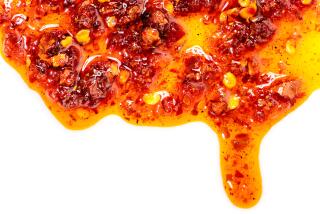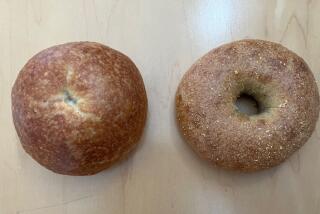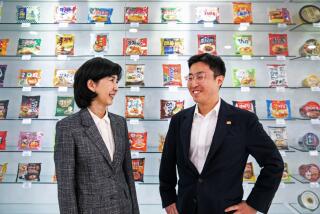Hot Pockets wants to be cool among foodies
To the parade of familiar products that are remaking themselves to lure foodies, add this unlikely entrant: the Hot Pocket.
The brand wants to ditch its decades-long reputation as a thawed-out brick of dough with machine-cut blocks of lunch meat. Instead, it wants the microwaveable turnovers to be taken seriously as a sandwich with street cred among gastronomes.
Hot Pockets, owned by Nestle USA in Glendale, is approaching its 30th anniversary by revamping ingredients, packaging and promotion in what Marketing Director Daniel Jhung calls “the biggest relaunch in the history of the brand.”
The hope is to better appeal to the so-called millennial generation of young foodies while escaping from a recent revenue rut.
To do it, the company is stuffing its dozens of Hot Pockets varieties with more upscale ingredients, including premium meats such as shaved hickory ham and slow-cooked Angus beef. The two new types of crust include a buttery garlic option and a crispy version akin to a savory croissant.
PHOTOS: Top cities with falling wages
The items, made in kitchens in Chatsworth and Kentucky, will be available not only in grocery stores but also via the recently expanded Amazon Fresh online delivery program.
Celebrity chef Jeff Mauro, host of the Food Network series “Sandwich King,” has signed on to plug the updated products and potentially even design a Hot Pocket himself.
“It’s had a resurgence,” Mauro said of the snack brand’s public awareness.
But over the last few years, Hot Pockets sales — along with revenue throughout the frozen sandwich category — have declined slightly, Nestle said. Early last year, the company laid off a sixth of the Chatsworth factory’s staff, or more than 100 workers, and trimmed the production week to four days from six.
“People think frozen food is bland,” Jhung said. “We’d like to break that perception, to reintroduce it like something you’d make at home, just on a bigger scale.”
As consumers become more epicurean, more aware and accepting of unexpected tastes and more adamant about sourcing, fast-food restaurateurs and packaged-food manufacturers are scrambling to adopt culinary strategies pioneered at more high-end establishments.
“The food standards for the millennial generation are increasing,” said Hot Pocket Brand Manager Kevin Holmes. “They may not be going to Bobby Flay’s restaurants, but they still expect a little bit of the same flavor. We wanted to raise our bar as well, step up our game a little bit.”
Nestle acquired the Hot Pockets brand from Chef America for $2.6 billion in 2002, at a time when freezer-aisle snacks were booming. Now, the company is spending millions of dollars on its advertising campaign, boosting its marketing budget as much as 20%.
The new Hot Pockets will roll out with packaging in bolder colors to attract young buyers. The boxes will also call out the fancy meats and crusts to draw the mothers responsible for two-thirds of Hot Pocket purchases, Holmes said.
Over the last 25 months, more than a dozen bakery technology, culinary and research and development employees have worked on the upscale Hot Pocket. Some went on food tours to major national gastronomy centers, such as New York and Chicago, occasionally visiting 14 restaurants a day.
Mauro is the first food celebrity to join the team, though the company has hired pitchmen in the past such as rapper Snoop Dogg and actor David Hasselhoff to represent its Hot Pockets and Lean Pockets brands.
Mauro has filmed a series of commercials in which he pulls people from the street to gauge their reaction as they try one of the new Hot Pockets. In another video, he tours the Hot Pockets kitchen, which he calls “my version of Willy Wonka — the most mesmerizing process on an enormous scale.’
“I think every young man has had a relationship with the brand,” he said, reminiscing about the broccoli cheddar Pockets his mother kept in the freezer for her four children.
Down the line, Hot Pockets is considering making its products in smaller sizes for consumers concerned about portion control. As for whether it’ll start using more natural ingredients, Jhung said, “We’re still working on it.”
Twitter: @tiffhsulatimes







